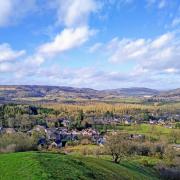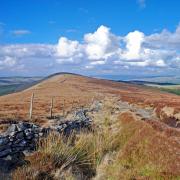Sally Mosley scans her bookshelf for a brief round-up of Peak visitors across the ages who were inspired to celebrate its people and places.

The Peak District is by definition an area of central England named not after its hills but because in Saxon times it was inhabited by a tribe known as the Peaklanders or Peakrills. Extending over most of north Derbyshire and into five neighbouring counties, its undulating landscape of picturesque dales, meadows, majestic moorland and string of sheer escarpments has over many centuries attracted writers and poets to put quill to parchment, pen to paper and fingers on keyboards.
It was probably Thomas Hobbes who really put this region on the map following his tour of the county, resulting in De Mirabilibus Pecci: Being the Wonders of the Peak in Darby-shire, written in Latin in 1636 and then translated into English in 1678. Charles Cotton penned his own version of The Wonders of the Peak in 1681 which is considered by some to be Derbyshire’s first official guide book. Then in 1697 Celia Fiennes, an adventurous traveller far ahead of her time, rode through Derby and visited Bretby as part of her tour of England, keeping notes of her exploits and experiences in a journal along the way. When her writings were discovered in 1885, more than a century after her death, they were published in a book entitled Through England on a Side Saddle.
Daniel Defoe (1660-1731) wrote A Tour Through The Whole Island of Great Britain based on travels undertaken during his lifetime. He visited Derbyshire in 1712 to take the waters at both Matlock Bath and Buxton. Being something of a connoisseur of hydrotherapy he describes the wonderful cures that had been wrought by those who visited spas ‘especially in rheumatic, scorbutic and scrofulous distempers, aches of the joints, nervous pains and also in scurvy and leprous maladies.’ Defoe goes on to describe the act of bathing in our thermal waters as being ‘a kind of equality in the warmth of your blood and that of the water, so very pleasant, that far from the fainting and weakening violence of the hot baths, on the contrary, here you are never tired and can hardly be persuaded to come out of the bath when you are in.’
It was in the 19th century Victorian era when travel writing picked up speed. Turnpike roads had been established that made journeying by carriage easier and more comfortable. Railway lines were also being laid at an impressive and express rate, making it possible to escape the conurbations and city smog for a quick and easy outing into countryside at the cost of a cheap away-day return ticket. Consequently a plethora of books was published, many enthusing over the charm and delights of Derbyshire in romantic verse and prose, sometimes written in a style now considered somewhat hard to digest and illustrated with idealistic pictures or utopian scenic prints. These books generally portrayed the Peak District as an Elysian land of milk and honey, packed with legends and lovers leaps.

On the other hand, History of Derbyshire by John Pendleton dedicates several chapters to what we now refer to as the Dark Peak area on the outskirts of Sheffield. Published in 1886 it provides a valuable insight into working conditions at that time: ‘Black Brook – whirling after every storm in madcap glee into the grand, wide-stretching valley of Rivelin – cannot, pretty as it is, compare with the wilder beauty of another stream, the Wyming Brook, that tumbles recklessly down the fir-capped glen just beyond, opposite Hollow Meadows. This glen is one of the favourite haunts of the Sheffield workman. Here he is free from the grime of the workshop, and the excessive heat of the armour-plate mill. Amid “the sights and sounds of nature” he forgets for the moment his toil for bread, and his smoke-begrimed dwelling in Attercliffe or Brightside, or in the dreary region of the Crofts. He gets new breath, new life, new hope in this little hillside fastness; and it is such a lovely spot that after dragging you there, you will admit that however dismal Sheffield may sometimes be, it is a black diamond set in emeralds – a sooty Vulcan or Cyclops slaving on the borders of a paradise.’
With occasional sentimental stanza and narrative verse, Pendleton injects humour and honest description into his writing. Whilst relating a trek through the ‘sylvan pomp of woods’ to ‘heather-clad, rush-covered country’ near Stanage Pole he includes the following few lines of sheer magic:
‘Onward we climb and upward pass
By that old causeway track,

Where long, long went in olden time
The pedlar with his pack
With carrier horses, laden well,
Their progress cheered by jingling bell.’

By the end of the 19th century the world appeared to have become much smaller with modes of travel being quicker and affordable. Not yet able to fly, the affluent holidaymaker could nevertheless cruise the high seas in comfort. The British Empire extended into the farthest reaches that could be pinpointed on a fashionable globe, while the Industrial Revolution had provided enough wealth to allow a percentage of the population to afford foreign travel. However, when Edward Bradbury compiled All About Derbyshire in 1884, which he illustrated with 60 attractive plates, he was plugging for ‘staycation’ trips, a term recently invented but with a meaning at least a century old.
Bradbury begins Chapter One – ‘Undiscovered Derbyshire’ – with a quote from the Daily Telegraph of 2nd July 1883 pleading the cause of English scenery and the relative comforts of home travelling, ‘Thousands and thousands who know Switzerland by heart have never set foot in Derbyshire.’ Then in almost ‘ten commandment’ style he continues, ‘Know most of the thresholds of thy native country before thou goest over the threshold thereof.’ He goes on to sing the praises of Derbyshire’s dales, hills, halls, spas and railways, relating his experiences travelling through the Peak on the ‘Engine of the Express’. ‘If we cannot be said to actually possess the magic Arabian carpet we have at least electric telegraphs, telephones, Atlantic cables, Cunard steamers and Flying Scotchmen.’
Another advocate of holidaying at home was Eliza Cook, the 19th century English author and poet who wrote prophetically along the same lines, one of my own personal favourites being:
‘And Monsal, thou mine of Arcadian treasure,
Need we seek for Greek islands and spice-laden gales,
While a Temple like thee, of enchantment and pleasure,
May be found in our own native Derbyshire Dales.’
By the start of the 20th century, visitors to the Peak District had toughened up. They didn’t want to just to sit and look at the scenery, but were prepared to ‘take a walk’, hike over the hills and return home with a bit of mud on their dainty leather shoes or hobnail boots.
In 1891 John Leyland had produced The Peak of Derbyshire, Its Scenery & Antiquities, describing itself in the introduction as ‘a useful companion for tourists’, although as rather a large tome it wouldn’t have been easy to carry around.
The Little Guide – Derbyshire by Thomas Tudor must have been a godsend to ramblers when it first appeared in 1903. Pocket-sized and practical it was regularly updated and still in print 50 years later, and by the time of the fifth edition it was packed with monochrome photographs.
Black’s guide of 1904 was a sensible size, too, its inside cover listing an alphabetical choice of 60 books available in the series from Bath & Bristol 6d net to Wye, The 1s. Beyond the index at the back was an advertisement for Dinneford’s magnesia (no doubt to calm indigestion and travel sickness) along with accommodation listings for hotels, making it a concise but all-round visitor guide.
In the 1930s, The Peak District compiled by M J B Baddeley, BA went one step further and incorporated maps and plans, probably one of the first walking guides to be produced, albeit somewhat vague and with few instructions but impressively packed with snippets and advice on local inns!
Following the mass trespass in April 1932 rambling really took off. By the end of the 20th century hiking boots had become cheap and affordable; rucksacks lightweight, and the ingenious invention of Gore-tex and lycra brought comfort, waterproofing and breathability, although it still remains a fact that only good fitness can combat the ‘out of breath’ challenge required to conquer our highest hills.
Into the 21st century, and the market is now flooded with a superabundance of travel guides and walk books. There are TV channels dedicated to travel and we regularly see flavour-of-the-month celebrities extolling the virtues of walking our countryside whilst popping up to advertise attractions. Internet searches reveal a long list of apposite websites and available downloads, whilst smart phones offer appropriate apps.
Visitors from near and far arrive and depart in a constant ebb and flow to discover the delights that many residents may take for granted. But if you know your Peak District well and can choose your time and location wisely, it is still possible to step back in time and visit areas that are unspoilt and have remained unchanged over the centuries, to look through the eyes of those early writers at the wonders of our glorious Peak District and Derbyshire.



























